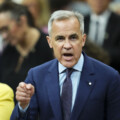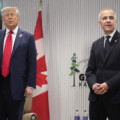Pierre Poilievre, by all indications, is poised to be the next prime minister of Canada. He has not, in the long lead-up to the next election, been shy about his intentions to get federal spending under control. The chatter in Official Ottawa, amongst those in government and those in media with a keen eye on those in government, is that this may be a more difficult task than he’s proclaiming it to be. How much wiggle room is there, really, once you factor in much-needed fiscal transfers to the provinces—and is it really politically feasible to coldly cut them off in a fit of budget-balancing pique?
Maybe, maybe not. But it is worth taking a look at the state of the government’s actual accounting when it comes to how much they are spending—and on what—to see where a future government might find some savings.
The numbers coming out of Ottawa are simply staggering. The federal deficit was forecast in the last budget to hit $40 billion this year, up from $35 billion the year before, but it could come in at more like $56 billion with the way that spending keeps increasing. As a result, our national debt is now forecast to hit more than $1.2 trillion, or almost double what it was when the Trudeau Liberals took power in 2015. Rising interest on that debt will cost taxpayers $54 billion this year alone.
Federal spending is up this year by $37.1 billion to more than $534 billion, an increase of 6.9 percent. The civil service added more than 10,000 names to the federal payroll last year, bringing its bloated total to 367,772, which is up by 42 percent since Trudeau took over. The cost of paying their ever-increasing salaries hit a record $67 billion last year, up by 68 percent since 2016.
Where does all the money go? Social spending keeps increasing under new programs such as the dental care plan, while corporate subsidies are soaring out of sight, hitting $11.2 billion at last count in 2022, which is more than twice what they were in 2015. About $57 billion has been promised to multinational corporations including Honda, Volkswagen, and Stellantis to produce EVs alone.
It’s no wonder that we have such a bloated bureaucracy in Ottawa. The government has to keep hiring more and more staff just to keep giving away more and more of our money. To keep up with its ever-increasing spending, Ottawa is scrambling to raise taxes as fast as possible, increasing capital gains taxes and breaking new ground by taxing and regulating the internet with legislation such as the Online Streaming Act and the Digital Services Tax.
The granular detail of Ottawa’s out-of-control spending is outlined annually in Canada’s public accounts, so the truth is out there for anyone who has the time, inclination, and iron stomach needed to go through the more than 400 pages listing who gets what. For 2022-23, which is the most recent year available, transfer payments totaled $249,493,365,140, or a quarter of a trillion dollars.
To put that into context, Canada’s GDP is about $2.8 trillion. These transfer payments are up 52 percent from the $163,690,388,177 they totaled just five years earlier. Not only does the dollar amount keep going up, but so does the number of recipients, as evidenced by the 25-percent increase in the number of pages needed just to list them all. Only those who got $100,000 or more are listed, so we may never know some of the recipients of federal largesse, but the public record includes many that raise an eyebrow or even two.
The profligacy is listed alphabetically by federal department, starting with Agriculture, which dispensed more than $2.8 billion in 2022-23, which is more than double the $1.27 billion it gave out just five years earlier. Of that, a cool $1 billion went to the AgriInsurance program, including $393 million to the Saskatchewan Crop Insurance Corporation, which was up 82 percent from the $216 million it cost in 2017-18. It gave out another $459 million under the Dairy Direct Payment Program, $73.5 million more in support of the Poultry and Egg On-Farm Investment Program, and almost $80 million to the Canadian wine industry (which at least is something I can get on board with, especially after digesting all these numbers).
Several federal departments have seen their disbursements rise exponentially in the past five years, including Immigration, whose more than doubled from $1.3 billion to $2.8 billion, Public Safety, whose more than tripled from $1 billion to $3.5 billion, and Indigenous Services, whose quintupled from $3.5 billion to $17.7 billion.
The Department of Canadian Heritage handed out just over $2 billion, up by more than half from $1.25 billion in 2017-18. That included $359 million to the Development of Official-Language Communities Program, $221 million to the Enhancement of Official Languages Program, almost $250 million to the Sport Support Program, and $36 million to the Celebration and Commemoration Program.
It gave almost $152 million to the Indigenous Languages and Cultures Program, $62 million to the Canada Performing Arts Workers Resilience Fund, $13 million to the Indigenous Screen Office, $12 million to the Multiculturalism and Anti-Racism Initiatives Program, and $10.8 million to the Anti-Racism Action Program. More than $41 million went to the Hosting Program, including $7.5 million to the 2023 Canada Winter Games Host Society, Charlottetown, and more than $12 million to the Canada Games Council. The Canada Arts Presentation Fund got $26.5 million, the Canada Arts Training Fund got $25 million, and the Building Communities through Arts and Heritage Program got a similar amount. Another $31 million went in grants to the Athlete Assistance Program, while $42 million more went to the Canada Arts Presentation Fund.

Minister of Canadian Heritage Pascale St-Onge speaks with media in the Foyer of the House of Commons about funding for the CBC, in Ottawa, Monday, Dec. 4, 2023. Adrian Wyld/The Canadian Press.
Some new departments were handing out money in 2022-23 that didn’t even exist five years earlier, such as Women and Gender Equality and Youth, which was formerly known as Status of Women Canada. Its expenditures ballooned more than tenfold along with its mandate, from $20.8 million in 2017-18 to $259 million in 2022-23. Its payments go on for eight pages, including $183,000 to the 2 Spirits in Motion Society of Vancouver, $165,496 to the Alliance for South Asian AIDS Prevention, $130,000 to La Coalition des familles LGBT, $130,000 to the Edmonton 2 Spirit Society, and $107,320 to Archives lesbiennes du Québec.
The data help to put into context the recent debate over subsidies for news media in Canada prompted by the Ottawa Declaration on Canadian Journalism issued recently by the Macdonald-Laurier Institute, to which the founders of The Hub were signatories. It called on news media to stop taking the payroll tax credits they have been issued since 2019, which amount to $35 million a year. That’s in addition to the $15 million doled out annually to improve news coverage in under-served communities by the Local Journalism Initiative.
These amounts combined are a lot less than the $87 million given to magazines and weekly newspapers in 2022-23 from the Canada Periodical Fund administered by the Department of Canadian Heritage. All three put together are less than the $190 million given out to fund audio-visual production from the Canada Media Fund. Those four combined total less than the $335 million estimated to have been handed out last year in Film or Video Production Tax Credits.
Cultural subsidies infest our public accounts, including $58 million to the Canada Music Fund and $61 million more to the Canada Book Fund. The Canada Cultural Investment Fund dispensed more than $25 million for such worthy causes as ballet, opera, and symphonies. The Canada Cultural Spaces Fund distributed another $74.4 million for such things as art galleries, theatres, museums, and historical parks, of which $2.65 million went to the Calgary Stampede Foundation. The Canadian Canoe Museum topped that list at $6.89 million, followed by La fondation du théâtre du nouveau monde in Montreal at $6 million, while the Thunder Bay National Exhibition Centre and Centre for Indian Art got $4.88 million.
About 900 publishers and industry associations received subsidies from the Canada Periodical Fund in 2022-23. Topping the list at $6.8 million was TVA Publications, which is owned by Quebecor and publishes TV guides and celebrity magazines affiliated with its French-language television network TVA. Reader’s Digest, which recently ceased publication in Canada after 76 years, got $2 million from the CPF last year. Postmedia Network, which publishes dozens of community newspapers and specialty publications along with most of Canada’s largest dailies but is 98 percent owned by U.S. hedge funds, got $1.3 million from the CPF in addition to more than $7 million in payroll tax credits from the federal and Québec media bailouts.
Subsidies for magazines in Canada are long-standing and lucrative. Maclean’s got $1.2 million last year, Zoomer got $864,851, Canadian Geographic got $711,922, Toronto Life got $636,974, Cottage Life got $540,310, and The Walrus got $517,637. The publisher of House & Home and other magazines got $1.1 million. Highly unlikely publishers such as the Retired Teachers of Ontario got $245,256 last year, while Old Autos Publications got $144,681, Ontario Snowmobiler Publishing Ltd. got $112,377, and the Ontario Federation of Anglers and Hunters got $523,687.
Obscure publications are also on the dole, such as Vancouver-based Modern Dog magazine, which got $173,934, while the publisher of health and wellness magazine Alive got $284,371. Online-only publications also now get grants from the CPF, with Vancouver’s long-publishing news website The Tyee getting $149,680 last year and Village Media, which publishes dozens of local news outlets across Ontario, receiving $531,068. The Logic, an online business and technology publication, also got $149,680. Even the industry associations that lobby for media subsidies get government money. News Media Canada, which has recently led two campaigns for federal bailouts, got $367,294 from the CPF in 2022-23.
Does the entire population get federal handouts? How much time and effort goes into filling out all the paperwork required to collect these entitlements? Most of all, how are we going to keep paying for all these handouts? Or perhaps a fundamental rethinking of our federal largesse is long past due.








